Victoria Harbour (British Columbia)
Victoria Harbour is a harbour, seaport, and seaplane airport in the Canadian city of Victoria, British Columbia. It serves as a cruise ship and ferry destination for tourists and visitors to the city and Vancouver Island. It is both a port of entry and an airport of entry for general aviation. Historically it was a shipbuilding and commercial fishing centre. While the Inner Harbour is fully within the City of Victoria, separating the city's downtown on its east side from the Victoria West neighbourhood, the Upper Harbour serves as the boundary between the City of Victoria and the district municipality of Esquimalt. The inner reaches are also bordered by the district of Saanich and the town of View Royal. Victoria is a federal "public harbour" as defined by Transport Canada. Several port facilities in the harbour are overseen and developed by the Greater Victoria Harbour Authority, however the harbour master's position is with Transport Canada.

Aerial view of Victoria Harbour up to Selkirk Water, 11 December 2008
Sternwheeler William Irving on left and sidewheeler George E. Starr on right, in the 1880s
Watercolor painting of the southwest bastion of Fort Victoria with harbour to the left by Sarah Crease (wife of Henry Crease), 8 September 1860
The Empress Hotel overlooks James Bay and the Causeway Floats (2018)
Victoria, British Columbia
Victoria is the capital city of the Canadian province of British Columbia, on the southern tip of Vancouver Island off Canada's Pacific coast. The city has a population of 91,867, and the Greater Victoria area has a population of 397,237. The city of Victoria is the seventh most densely populated city in Canada with 4,406 inhabitants per square kilometre (11,410/sq mi).
From the top, left to right: the British Columbia Parliament Buildings; Downtown Victoria; Craigdarroch Castle; Christ Church Cathedral; the Empress Hotel; and the Float Home Village at Fisherman's Wharf
View of Victoria from James Bay in 1862. The city was incorporated that year as a result of the Fraser Canyon Gold Rush.
Royal Canadian Naval Volunteer Reserve members stand outside the British Columbia Parliament Buildings in 1914
Bird's-eye view of Victoria in 1889. After the completion of the Canadian Pacific Railway in 1886, Victoria lost its position as the commercial centre of the province to Vancouver.








